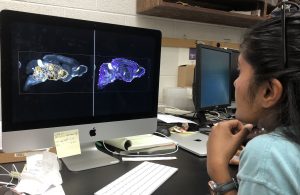After the relevant behavior is done, we analyze the mice brains for protein markers of synaptic connectivity and plasticity using immunofluorescent staining and microscopy. We use whole brain imaging approaches to determine relevant anatomical areas of interest.

PNNs are labeled in Green; DAPI in Blue in medial (left) and lateral (right) sections
We focus on perineuronal nets (PNNs) as markers for structural plasticity in the cortex, based on our previous work and other relevant literature. PNNs are extraceullar matrix structures that facilitate or inhibit synaptic plasticity. PNNs mainly surround Parvalbumin+ GABAergic interneurons in the cortex.
Major Questions:
- What brain regions show differential expression in PNNs during different learning and consolidation of behaviors?
- Are there brain-region or circuit-specific changes in PNNs in MECP2-deficient mice or are changes global?
- What are the roles of PNNs in synaptic plasticity and behaviors?
- What types of cells do PNNs surround in non-cortical areas?
Manual counting, mostly done by undergraduates interested in gaining lab experience, is extensively used to characterize PNN expression. We observe and quantify patterns of PNN changes in the cortical layers and in other brain regions.
We also use computational approaches to count and visualize PNNs throughout the mouse brain. The image below utilizes an interactive framework to visualize and analyze whole brain maps with cellular resolution to assemble 2D  sections into 3D whole brains. This approach allows us to investigate cortical layer-specific PNN expression, connectivity boundaries and other regions with PNN expression in detail.
sections into 3D whole brains. This approach allows us to investigate cortical layer-specific PNN expression, connectivity boundaries and other regions with PNN expression in detail.
One representative brain is shown here after this 3D visualization process. Dark green color represents PNNs in the somatosensory cortex, teal in visual cortex, red in thalamus/hypothalamus and pink in the midbrain.